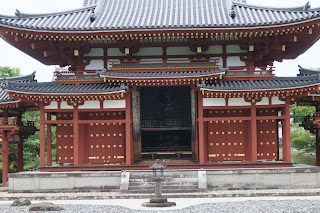Byodo-in ("Temple of Equality") is a Buddhist temple in the city of Uji in
Kyoto Prefecture, Japan, built in the late Heian period.
It is jointly a temple of the Jodo-shu (Pure Land) and Tendai-shu sects.
In East Asian Buddhism, there is the Three Ages of Buddhism, which are three
divisions of time following Buddha's passing. The Mappo, which is also
translated as the Age of Dharma Decline, is the degenerate Third Age of
Buddhism, also known as the Latter Day of the Law. It was widely believed that
the year 1052 marked the first year of the beginning of the end-of-the-world.
This theory captured the heart of many aristocrats and monks, which as a
result, people became more devout in Buddhism and believed in the ideology of
Buddhist Pure Land. In the following year, Amida-do Hall (Phoenix Hall) was
completed in whose interior sits the 2.4 meters tall Amida Buddha statue
created by Jocho, who is claimed to have been the best Buddhist sculptor in
the Heian Period.
|
Main gate (Omotemon).
Entering Byodo-in Temple.
|
|
Phoenix Hall seen from the north.
The main building in Byodo-in, the Phoenix Hall consists of a central
hall, flanked by twin wing corridors on both sides of the central hall,
and a tail corridor.
- The central hall houses an image of Amida Buddha.
|
|
Phoenix Hall seen from the northeast.
The Phoenix Hall, completed in 1053, is the exemplar of Fujiwara Amida
halls.
-
It consists of a main rectangular structure flanked by two L-shaped
wing corridors and a tail corridor, set at the edge of a large
artificial pond.
-
Though its official name is Amida-do, it began to be called Hoo-do, or
Phoenix Hall, in the beginning of the Edo period.
-
This name is considered to derive both from the building's likeness to
a phoenix with outstretched wings and a tail, and the pair of
phoenixes adorning the roof.
|
|
Hall of the Phoenix seen from the east.
Inside the Phoenix Hall, a single image of Amida (c. 1053) is installed
on a high platform. The Amida sculpture is made of Japanese cypress and
is covered with gold leaf.
-
The statue measures about three meters high from its face to its
knees. Sitting in a meditation position with his back slightly
hunched, his body is relaxed without any tension.
-
His hand gesture is called 'Inso', which both hands are placed on the
lap, palms facing upward, thumbs and forefingers form a circle. This
gesture is a variation of the Dhyana Mudra (Meditation Mudra), which
suggests concentration of the Good Law.
-
The Urna, which is the white dot on his forehead between the eyes, is
the Third Eye of the Amida Buddha, a symbol of awakening and the
ability to see the suffering of all creatures.
-
The serene smile of the statue represents the nobility of the Buddha
after attaining Enlightenment. With a harmonious and gentle facial
expression, he is looking slightly downward, which shows the state of
meditation, as well as the feeling of merciful grace towards the
audience.
-
His hair is short and curled, along with Ushnisha, which is the
pointed topknot located on the center of the head.
-
Applied to the walls of the hall are small relief carvings of
celestials, the host believed to have accompanied Amida when he
descended from the Western Paradise to gather the souls of believers
at the moment of death and transport them in lotus blossoms to
Paradise.
-
Raigo paintings on the wooden doors of the Phoenix Hall, depicting the
Descent of the Amida Buddha, are an early example of Yamato-e,
Japanese-style painting, and contain representations of the scenery
around Kyoto.
|
|
Jodo-shiki garden with pond.
There is a Jodo-shiki garden with a pond in front of the building, which
in 1997 was dredged as part of an archeological dig.
-
As the temple faces the East, it suggests that the audience need to
cross the Aji-ike pond in front of the Phoenix Hall, in order to reach
Buddhist Pure Land.
|
|
Hexagonal Hall (Rokkakudo).
|
See also
Source
Location















